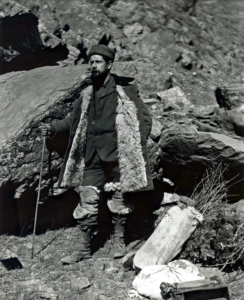‘Indicas’ cultivated in America in 1913 at the United States Department of Agriculture (USDA) research station in Nevada.
‘Kandivi’ is the Uyghur name for this Indica-type cannabis landrace that was once cultivated around the oases and irrigated valleys south of Yarkand, a historic hashish-producing centre in a region of eastern Central Asia known as East Turkestan or Xinjiang. In all likelihood, the name ‘kandivi’ is not a strain name so much as a way to differentiate this drug-type crop from Chinese fibre and oilseed types.
Collected in 1910 by the plant hunter Frank Meyer for USDA, these are likely the first true Indicas to grow in the United States. No surprise, the government crop scientists in Nevada noted their ‘skunky odour’.

Frank N. Meyer in the field. Special Collections, USDA National Agricultural Library
Something of an unsung hero, Meyer is perhaps most famous for the ‘Meyer lemon’, but over his career collected a vast array of other plants. Often trekking more than 10 miles each day on his missions inside China, Meyer obtained seeds of ‘kandivi’ on a gruelling expedition into the desert mountains south of Yarkand during the brutal Central Asian winter.
The Uyghur homeland of Xinjiang was at this time the eastern epicentre of the global hashish trade, each year exporting thousands of tonnes of dry-sieved charas southward through the Hindu Kush and Kashmir to feed the vast demand from Indian megacities such as Lahore.
On the back of several bloody, failed Uyghur independence uprisings, this Trans-Himalayan charas trade came to a sudden halt in the 1930s when the Chinese nationalists (Kuomintang / KMT) – under no international legal obligation to do so – implemented crop eradication programs across Xinjiang.
The Kuomintang intended these anti-cannabis campaigns to both root out perceived British and Indian influence (the charas trade and money lending) and begin the economic disenfranchisement of the Uyghurs, who now faced a rapid influx of Han settlers. So began the first waves of the ‘ethnic cleansing’ of Xinjiang.






